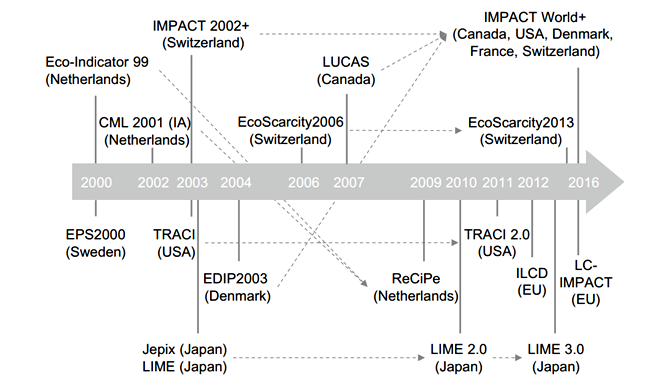This step is devoted to the assessment of the potential human and ecological effects of energy, water, and materials used and discharged to the environment. In an impact assessment it is mandatory to do the following:
- Selection of impact categories, category indicators, and models.
- Classification, in which inputs and outputs identified in the inventory analysis are grouped into impact categories or indicators (i.e. CO2, CH4, and N2O emissions are classified as contributing to the global warming potential category; NH3 emissions, NOx and SOx, and other emissions contribute to acidification potential, and VOCs, CH4, NOx, benzene, hexane among other substances contribute to the photochemical oxidation potential).
- Characterization, which involves the quantification of the potential contribution of the inputs and outputs to the environmental impacts, which allows them to be aggregated into a single value by weighting. The following are some examples: Global warming potential, expressed in kg equivalent of CO2, receives contributions from CO2, CH4, N2O and other emissions. Ammonia, H2S, HCl, NOx and SOx and other emissions contribute to the acidification potential, which is calculated in kg equivalent of SO2. VOCs, CH4, NOx, benzene, hexane and other emissions contribute to the photochemical oxidation potential which is expressed as kg equivalent of C2H4.
- Normalization, which consists in the evaluation of the environmental profile generated in the previous steps, by establishing the weight of each category. This stage allows the dimensionless of the categories and the comparison between them. The value obtained in each category can be relativized concerning a reference quantity, which can be, for example, the value of that category in question for the whole world activity, or the country, or the region where the study was carried out.
- Weighting, where the environmental profile is reduced from a set of indicators to a single impact score, by using weighting factors based on subjective value judgments. The weighting between categories is a step with a certain degree of subjectivity and is rarely carried out in LCA studies.
The different life cycle impact assessment methodologies can be cluster into two main groups depending on the final assessment goal: i) environmental impact assessment: in here, some methodologies result in the definition of an environmental profile, by quantifying the environmental effect on various categories over the product, process or service analyzed. In contrast to the second group of methodologies, this reaches only to evaluates indirect or intermediate effects about the human being (i.e. midpoints); ii) assessment of damage: these methodologies analyze the ultimate effect (i.e. endpoints) environmental impact, where they try to identify and define the damage caused to humans and natural systems.
According to (ISO, 2006b), the selection of the impact categories should consider the following aspects:
- the categories are nor redundant and do not lead to double counting;
- they do not disguise significant impacts;
- they are complete, and; iv) they allow traceability.
On the other hand, other relevant questions to be addressed during the selection of LCIA methods are (Hauschild, M.Z., Rosenbaum, R.K. and Olsen 2018):
- what kind of environmental issues are needed to be covered?;
- in which region the study is taking place?;
- are mid- or endpoints needed to be assessed, or both?;
- which elementary flows are needed to be characterized?;
- how well is the method documented?;
- how practical will be to communicate the results?;
- when was the method published and have there been important scientific advances in the meantime?
Some of the available life cycle impact assessment methods in LCA software are: ReCiPe, CML, TRACI, EDIP, LIME, IMPACT 2002+, CED, among others. Figure 4.2.1 shows the evolution of some LCAI methods around the world.

Table 4.2.1 includes the most common impact categories used in LCA studies.
| Impact category | Description |
|---|---|
| Global Warming Potential (GWP100) | It is related to emissions of greenhouse gases to the air. The characterization model as developed by the Intergovernmental Panel on Climate Change (IPCC) is selected for the development of characterization factors. Factors are expressed as Global Warming Potential for time horizon 100 years (GWP100) in kg carbon dioxide/kg emission (in kg CO2 eq.). The GWP is impacted mainly by greenhouse gases (carbon dioxide, CO2, and methane, CH4). It is calculated for a period of 100 years and it determines the contribution to global warming of a substance released into the atmosphere. IPCC 2007 GWP 100a methodology. |
| Acidification | It is caused by air emissions of NH3, NO2 and SOx. These acidic gases react with water in the atmosphere and form "acid rain". It causes a disturbance of varying degrees in ecosystems. It is measured by the Accumulated Exceedance (AE) in mol H+ eq/kg. CML 2001 methodology. |
| Fresh water ecotoxicity | It refers to the impact on freshwater ecosystems, as a result of emissions of toxic substances to air, water and soil. Ecotoxicity Potential are calculated with USES-LCA, describing fate, exposure and effects of toxic substances. Characterization factors are expressed as 1,4-dichlorobenzene eq/kg emission. CML 2001 methodology. |
| Cumulative Energy Demand (CED) | It quantifies the primary energy usage throughout the life cycle of a good or service. The method includes the direct and indirect uses of energy, but not the wastes used for energy purposes (Total CED). It is calculated as MJ. VDI 1997 method. |
| Abiotic resources depletion | It is related to the extraction of minerals and fossil fuels. The resource depletion factor is determined for each extraction of mineral or fossil fuel (the unit of reference is kg Sb eq) based on the concentration of the reserves and the decomposition index. The geographical scope of this indicator is global. |
| Eutrophication |
It is expressed in kg of PO4- eq/kg of emission. Destination and exposure are not included, the time horizon is infinite, and the scale Geographic varies between local and continental scale. |
Additional information related to the environmental impact categories selection can be accessed in more 4.2.1.






